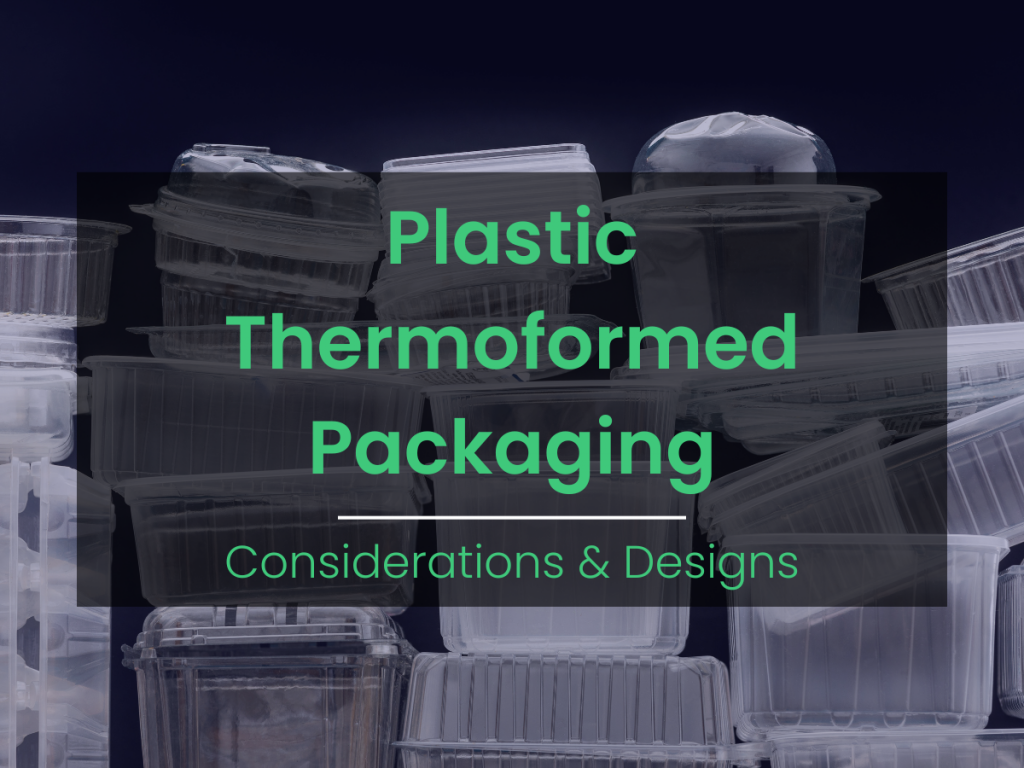Thermoformed packages are used in pharmaceuticals, cosmetics, food and beverage, and retail industries. It’s an incredibly versatile, customizable, and cost-effective form of packaging.
But before you jump in and make a purchase, our team at Complete Packaging Solutions is here to help you review a few design considerations.
Thermoformed Packaging Defined
Thermoforming involves using suction vacuuming, high heat, and high pressure to form three-dimensional shapes out of plastic sheets that have been placed into a rigid mold, then cut and assembled into packaging.
Related Post: Thermoforming Explained (Everything You Need to Know)
Types of Thermoforming
There are two types of thermoforming packaging: vacuum and heat-pressure thermoforming.
Vacuum Thermoform Packaging
Vacuum-forming plastic packaging is a cheaper and more streamlined option. Since you can’t produce that many packages, it’s ideal for short runs.
Plug-assisted forming is when a plug tool is put on the thermoforming machine to force the plastic-heated material into the female cavity.
The plug is made of urethane, aluminum, or syntactic foam. It ensures a consistent fill with the same thickness ratio for each run. It also helps to prevent webbing in the package.
Plug-assisted pressure forming is very similar, yet slightly different. Air vented underneath the plastic sheet puts pressure on the plug, blowing the molten plastic into a bubble.
The design won’t come out right if a consistent temperature isn’t held during the pressure-forming process.
Considerations Before Buying Thermoform Packaging
1. Quality Custom Design
The first step to creating great thermoform packaging is good design.
Talk to your packaging team about your product’s needs, your brand message, and your budget boundaries for materials.
During the consultation process, you’ll be able to narrow down precisely what kind of materials, tooling, machinery, and color scheme you need.
Does your product require special handling or materials to prevent moisture from getting through or to create additional insulation from temperature fluctuations?
The design team can help you identify suitable materials to use for your product.
Related Post: 5 Ways Thermoformed Electronics Packaging Boosts Revenue
2. Choose Packaging Materials
Your packaging company will select the appropriate plastic for your product.
- Most companies use PET (polyethylene terephthalate) or PETG (polyethylene terephthalate glycol).
- PET is often thinner and used for plastic water bottles.
- PETG is used for durable, thicker packaging, like blister packs for the pharmaceutical industry.
3. Manufacturing Process
This is the phase in which you’ll determine how your package will be constructed. What tools and processes will be used?
Typically, a turnkey packaging company will produce it all in-house, ultimately saving you money.
Thermoforming is famed for price-worthy tooling and low production costs, regardless of whether a company does it all themselves or outsources to another manufacturer.
4. Clean Production Environment
If you’re thermoforming products for the medical industry (and even the food industry), you’ll need to be sure that your packaging company is operating in a clean environment.
The best packaging facilities have an ISO class 8 cleanroom environment, with HEPA filtration and a positive pressure HVAC system.
5. Market Runtime
Designs need to be turned out quickly in order to prototype the material, perform a final test, and start creating order runs. A thorough prototyping process involving machine learning technologies reduces your production lead times.
There has to be enough time during the design and prototype phase to adjust for material shape, size, or coverage.
Thermoforming allows for precise and customizable changes to be made in an agile way.
6. Ergonomic Material Application
Before your package launches into the hands of customers, a final prototype is made, printed out to be held and reviewed in great detail for defects or drawbacks.
A good packaging company will collaborate with you during this process. After reviewing it, they might find a more profitable use for your packaging material.
For instance, removing great-looking but unnecessary inserts or narrowing the edges of the plastic package to fit the product better saves space, decreases weight, and lowers the overall cost of shipping.
Order Specialty Thermoformed Packaging from CPS
We offer customized, turnkey packaging solutions for mid and small-sized businesses looking to get their products to market faster. Request a free consultation today: (765) 547-1300

